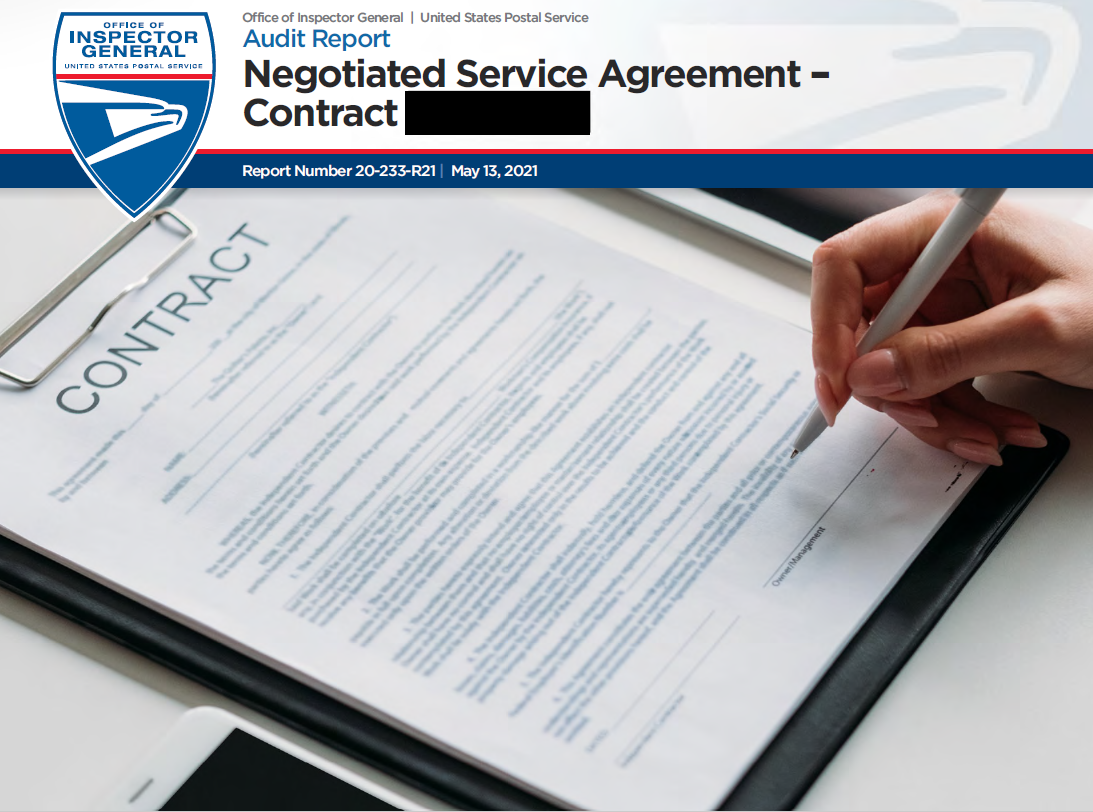
Objective
Our objective was to determine mailer compliance with Negotiated Service Agreement (NSA) provisions and evaluate the U.S. Postal Service’s oversight of NSA Contract [redacted]. We selected this NSA based on the mailer’s fiscal year (FY) 2019 volume and revenue.
An NSA is a contractual agreement between the Postal Service and a specific mailer, whereby the mailer receives customized pricing in exchange for meeting volume and using specific payment methods. The goal of using NSAs is to retain price-sensitive customers and encourage additional mail volume and revenue. While only a small fraction of Postal Service commercial package customers have NSAs, 40 percent of the Postal Service’s 5.5 billion domestic package volume is mailed under these agreements.
The Postal Regulatory Commission (PRC) approves all NSAs. The PRC approved Contract [redacted] in FY 2018. This three-year NSA provided special pricing for the mailer’s Priority Mail packages, Priority Mail Cubic packages, and First-Class Package Service. Pricing under this contract is based on the customer’s total volume of packages shipped in the previous quarter. Contract pricing is based on tiers, with each tier representing a minimum and maximum volume corresponding to specific price tables. The mailer agrees to ship a specified minimum volume of packages quarterly. The Postal Service has the right to revert to the most current Priority Mail Commercial Plus pricing and most current published First-Class Package Service commercial pricing in the subsequent contract quarter if the mailer does not meet these volumes.
The Postal Service provides several ways for commercial mailers to print postage and transmit shipping and payment information. This NSA specifies the customer will use either a PC Postage provider to print Postal Service shipping labels or the Postal Service’s proprietary electronic verification system (eVS) through a third‑party marketplace provider.
We reviewed this customer’s NSA mail volume, pricing, and payment system from [redacted].
Finding
The mailer was compliant with all agreement provisions we reviewed, including mail type, payment system, and volume commitments. In addition, the Postal Service provided adequate oversight of the NSA, which included quarterly business review meetings with the mailer to discuss contract performance, volume, and expectations.
However, we identified [redacted] of [redacted] packages ([redacted] that were mailed with an incorrect price or did not contain sufficient information to determine the correct price, such as a destination zone. These pricing errors totaled [redacted] from [redacted].
Of the total pricing errors, [redacted]) occurred because the Postal Service provided incorrect quarterly pricing rates to the customer’s PC Postage provider. The Postal Service did not receive all the customer’s volume data in time to determine the correct quarterly price adjustment because of a timing delay between postal systems. The Postal Service recognized this error and issued the customer a refund for the pricing discrepancy. During our audit, the Postal Service changed its processes to run volume reports seven days after the quarter close — versus five days — to account for future timing issues. However, automating such processes could reduce the risk of timing and manual process errors.
Other errors occurred because:
- An e-commerce platform charged incorrect prices for [redacted] mailings made during the period under review. Specifically, the customer was charged the commercial rate instead of the contract rate.
- The PC Postage provider did not update postage prices for [redacted] packages on time.
- The customer did not provide all necessary information to determine the correct price, such as the correct ZIP Code, for [redacted] transactions.
The Postal Service developed the Automated Package Verification (APV) system to automatically identify pricing errors, such as incorrect prices loaded by PC Postage providers and missing customer information. However, this system was [redacted]. We issued an audit report on the APV system in September 2019; the Postal Service expects to complete corrective actions for the issues we identified, including packages that [redacted]. Consequently, we will not make a recommendation related to APV. However, in the interim until APV can [redacted], the Postal Service should notify customers and their third-party PC postage or marketplace providers of the [redacted].
Recommendations
We recommended management consider developing an automated process to update pricing information with customers and vendors to eliminate timing and manual processing errors and notify customers and third-party PC Postage and marketplace providers of the pricing differences for appropriate adjudication.
Read full report
Source: USPS Office of Inspector General
